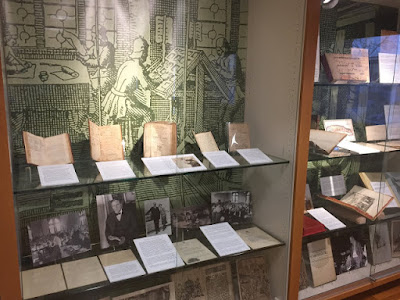In times of crisis, governments often produce a succession of orders, legislation, and judgments in response to rapidly changing events. Below are two selections from our spring exhibits that reflect on law in these kinds of situations. One can easily imagine the need for a Massachusetts Act to Prevent Monopoly and Oppression (1777), in response to price gouging during wartime. Eliminating 'public threats' during periods of civil unrest is often more suspect, as arguably in the case of Gracchus Babeuf. In all these cases, governments intervene in extraordinary ways to strengthen authority and maintain order, with various effects. The old Latin legal maxim, necessitas non habet legem ('necessity knows no law'), can perhaps be reinterpreted at these moments as 'necessity makes its own law (necessitas facit suam legem). Of course, laws enacted in times of crisis and under emergency justifications still need analysis and critique from the perspectives of law and justice.
----
In the Year of Our Lord, One Thousand Seven Hundred and Seventy-Seven: An Act to Prevent Monopoly and Oppression (Boston: Printed by B. Edes and Sons, 1777).
During the American Revolution, the Massachusetts legislature passed a law to regulate prices in the face of limited supplies and increasingly “avaricious conduct.” The single act, published for immediate distribution, sets prices for a range of colonial goods named in it. At the back of our copy, in a clear and elegant hand, a selection of the goods and their prices is arranged according to common measures (per bushel, per pound, etc.). The items listed were those used in cooking and maintaining a household: mentioned are things like tallow, women’s shoes, and cloth for spinning. No ownership information tells us who wrote the list; one guess may be a colonial woman who ran a household. The pamphlet provides a direct and vivid window into daily economics in the midst of the Revolutionary War. Despite the crisis, the owner has organized the items with a sense of practical care necessary in the face of adversity.
---
The Trial of Gracchus Babeuf before the High Court of Vendome, ed. and trans. by John Anthony Scott (Northhampton, MA: The Gehenna Press, 1964).
François-Noël Babeuf (1760-1797), known as Gracchus Babeuf, was a French revolutionary and reputedly one of the first communists, who advocated the abolition of private property. A prolific writer, he rose to prominence as a new
French government faced economic crisis and widespread suffering, with little effective remedy. He was tried and executed in 1797 for fomenting rebellion. The Defense is a modern translation of Babeuf’s apologia on his own behalf at his trial, where he invoked intellectual fathers of the French Revolution Rousseau and Diderot.
The copy in our collection is a modern, beautifully illustrated edition featuring twenty-one etched portraits, including French Enlightenment figures and Babeuf himself. The outstanding illustrations are by Thomas Cornell (1937-2012), who signed each image in pencil in the lower right. The etchings were printed by Emiliano Sorini in New York, on loose blue Fabriano paper that has been laid in; the text is gathered in unbound quires. The noted illustrator and artist Leonard Baskin, who founded the Gehenna Press, designed the book. Our copy is number 87 from a limited edition of 300, signed again at the back by Cornell. Our copy is a gift of Christa Cornell, the artist's wife.
- Ryan Greenwood, Curator of Rare Books and Special Collections






























